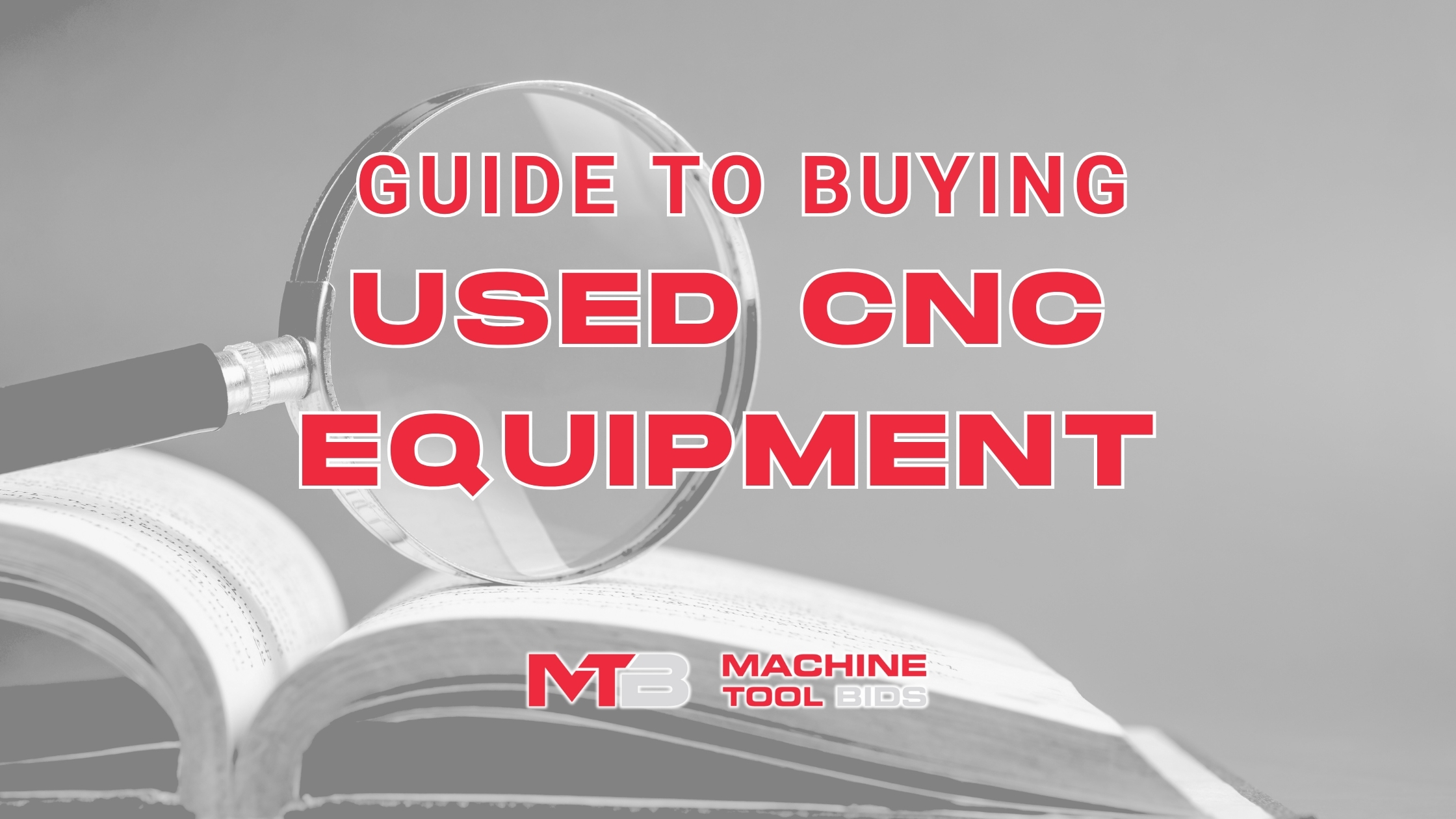Fiber Laser vs. CO2 Laser: A Complete Guide
When it comes to laser cutting, engraving, and marking, two of the most popular technologies are fib...
Read More CNC machinery
CNC machinery

Author: Matt Spiller | 21 October 2025
Finding a used CNC machine for sale can save your business thousands while getting the precision equipment you need. This guide is for machine shop owners, manufacturers, and fabricators who want to buy used CNC equipment without the hefty price tag of new machinery.
Smart buyers know that second hand CNC machines can deliver the same quality results as new equipment when you know what to look for. We'll walk you through the key advantages of choosing pre-owned CNC machinery over brand-new models, and show you exactly what to inspect before making your purchase.
You'll also discover the best places to buy used CNC machines, from online marketplaces to local dealers, plus get a complete checklist to inspect used CNC machine components like a pro. Ready to find reliable equipment that fits your budget?
Checking the physical condition of a used CNC machine for sale starts with examining the machine bed for wear patterns, cracks, or signs of abuse. Look for oil leaks around hydraulic components and check if all safety guards remain intact. Request maintenance records from previous owners to understand how well the pre-owned CNC machinery was cared for. Regular maintenance schedules indicate responsible ownership, while missing documentation might signal potential problems. Pay attention to the cleanliness of the machine - well-maintained used CNC equipment typically shows pride of ownership through proper housekeeping and organized tooling areas.
The spindle represents the heart of any used CNC machine, so testing its performance becomes critical before purchase. Run the spindle at various speeds while listening for unusual noises, vibrations, or grinding sounds that could indicate bearing wear. Check the tool holders for proper fit and condition, ensuring they match your existing tooling inventory. Verify the spindle's power ratings meet your production requirements and confirm the taper size works with your current setup. Second hand CNC machines often come with existing tooling packages, so evaluate whether these tools add value or create compatibility issues with your operations.
Modern CNC controls can make or break your productivity with used CNC equipment, so understanding the system becomes essential. Check if the control software receives regular updates from the manufacturer and whether technical support remains available. Older control systems might limit your ability to run newer CAM software or advanced machining strategies. Test all control functions including program loading, editing capabilities, and communication ports for data transfer. Consider the learning curve your operators will face when transitioning to different control interfaces, as training costs can add significantly to your used CNC machine buyers guide budget calculations.
Purchasing used CNC machines delivers immediate financial benefits that can transform your manufacturing budget. New CNC equipment typically costs 40-70% more than comparable pre-owned units, freeing up substantial capital for other business investments. A new machining center that retails for $300,000 might be available as a quality used CNC machine for sale at $120,000-180,000, depending on age and condition.
These savings extend beyond the purchase price. Used equipment often comes with existing tooling, fixtures, and accessories that would cost thousands separately when buying new. Many sellers include complete setups that help you start production immediately, rather than building everything from scratch.
Pre-owned CNC machinery has already absorbed the steepest depreciation curve that hits new equipment hardest in the first three years. When you buy used CNC equipment, you're stepping into a more stable value proposition where depreciation slows dramatically.
New machines lose 20-30% of their value within the first year alone. Used machines depreciate at roughly 5-10% annually after their initial steep decline, making them smarter investments for businesses focused on maintaining asset value. This slower depreciation rate means your equipment retains more resale value if you need to upgrade or liquidate assets later.
Second hand CNC machines open doors to high-end models that would otherwise exceed your budget as new purchases. Premium brands like Mazak, Haas, DMG Mori, and Okuma become accessible when shopping the used market. A top-tier machining center with advanced features, rigid construction, and proven reliability becomes financially viable through the used equipment market.
Many shops discover they can purchase multiple used machines for the price of one new unit, dramatically expanding their production capacity. This approach allows manufacturers to diversify their capabilities across different machine types and sizes while staying within budget constraints.
Used CNC equipment offers immediate availability compared to new machine lead times that can stretch 6-18 months. Manufacturing demand fluctuations create lengthy backlogs for new equipment orders, but used machines are typically ready for shipment within days or weeks.
This speed advantage proves crucial for businesses responding to urgent production needs or market opportunities. While competitors wait months for new deliveries, you can install and commission used equipment quickly, gaining competitive advantages through faster response times. Many used machine dealers maintain ready inventory and can arrange immediate delivery and installation services.
The spindle represents the heart of any CNC machine, so start your used CNC machine evaluation here. Check for excessive play in the spindle bearings by grabbing the tool holder and attempting to move it radially. Any noticeable movement indicates worn bearings that could cost thousands to replace. Listen for unusual noises during spindle rotation - grinding, squealing, or irregular sounds suggest internal damage.
Examine the linear guides and ways carefully. Run your hand along the machine's travel paths, feeling for scoring, pitting, or rough spots. These surfaces should feel smooth and consistent. Look for excessive wear patterns or discoloration that might indicate poor maintenance or crash damage. Ball screws deserve special attention since they directly affect positioning accuracy. Check for backlash by manually moving axes back and forth while monitoring the position display.
The tool changer mechanism requires thorough inspection on machining centers. Cycle through several tool changes, watching for hesitation, misalignment, or mechanical stress. Count available tool slots and verify they're not damaged or excessively worn.
Don't overlook the electrical components. Inspect used CNC machine control panels for cracked screens, missing buttons, or error messages. Check cable conditions, especially around moving joints where flexing occurs. Frayed wiring or loose connections can lead to intermittent faults that are difficult to diagnose.
Document any cosmetic damage, rust spots, or missing guards. While these might seem minor, they often indicate overall care level and can affect resale value.
Basic power-on tests only scratch the surface when evaluating used CNC equipment. Request permission to run the machine through actual cutting operations using appropriate materials. This reveals problems that static testing cannot detect.
Start with simple positioning tests across the full travel range. Program rapid moves to each axis limit, checking for smooth acceleration and deceleration. Any jerky motion, unusual vibrations, or positioning errors signal potential issues with drives, encoders, or mechanical components.
Load testing separates well-maintained machines from problematic ones. Run cutting operations at various feed rates and spindle speeds while monitoring performance. Heavy cuts reveal weaknesses in the spindle, drives, and structural components. Watch for chatter, poor surface finishes, or dimensional inaccuracies that might indicate worn components or alignment problems.
Test the coolant system under pressure. Verify all pumps function properly and check for leaks in lines, fittings, or the coolant tank. A failing coolant system can destroy expensive tooling and workpieces.
Pay attention to cycle times during automated operations. Compare actual performance against manufacturer specifications. Significant deviations might indicate servo tuning issues, worn mechanical components, or control system problems.
Monitor the machine's behavior during direction changes and corner rounding. Excessive following error or poor path accuracy suggests servo system problems or mechanical wear that will affect part quality.
Complete service documentation provides invaluable insights into a used CNC machine's history and future reliability. Request maintenance logs, repair records, and any available usage data like operating hours or part counts.
Examine preventive maintenance schedules and verify they were followed consistently. Regular lubrication, filter changes, and calibration checks indicate responsible ownership. Missing maintenance records or gaps in service history raise red flags about potential hidden problems.
Review any major repairs or component replacements. While some repairs are normal over a machine's lifetime, extensive work on critical systems like spindles, drives, or controls might indicate underlying issues or suggest the machine was operated beyond its capabilities.
Check for recall notices or service bulletins from the manufacturer. Some issues are widespread enough to warrant factory modifications or software updates. Verify these were completed if applicable to the specific machine model and serial number.
Original manuals, software, and tooling documentation add significant value when buying used CNC equipment. Missing documentation can create operational challenges and increase setup costs for new operators.
Warranty information, even expired warranties, provides insight into the machine's age and original configuration. Some manufacturers offer transferable warranties or extended service agreements that might still be valid.
Training records show whether operators were properly qualified, which directly impacts machine condition and reliability. Well-trained operators typically maintain equipment better and cause fewer crashes or operational problems.
Buying a used CNC machine can be one of the smartest moves for your business. You'll save thousands of dollars compared to new equipment while still getting reliable performance. The key is knowing what to look for and where to shop. Check the machine's maintenance records, run a complete inspection, and buy from trusted dealers who offer warranties.
Don't rush into any purchase without doing your homework first. Take time to test the machine's accuracy, examine wear patterns, and verify all components work properly. Start browsing reputable dealers, online marketplaces, and industrial auctions today. With the right approach, you'll find a high-quality used CNC machine that serves your shop well for years to come.